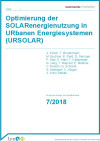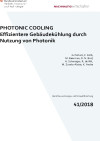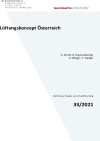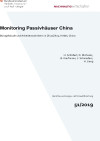Suchergebnisse für "Factsheet: Energietechnologien gestalten, die für alle sinnvoll und nutzbar sind"
Climate communities
Transdisciplinarily developed climate-friendly solutions for decarbonisation of the building stock in small and medium-sized municipalities. The application of the sample solutions will readily identifiable through a web tool.
Optimierung der SOLARenergienutzung in URbanen Energiesystemen (URSOLAR)

URSOLAR stellt EntscheidungsträgerInnen eine Roadmap zur integrierten urbanen Solarenergie-nutzung zur Verfügung. Es wird aufgezeigt, wie Photovoltaik (PV) und Solarthermie angepasst an infrastrukturelle und rechtliche Gegebenheiten in idealtypischen Stadtquartieren aus ökonomischer, ökologischer und sozialer Sicht sowie unter Berücksichtig von Stakeholder-Interessen optimal ge-nutzt werden können.
Schriftenreihe
7/2018
A. Posch, T. Brudermann, M. Buchner, E. Fleiß, D. Geringer, P. Hart, S. Hatzl, T. Kallsperger, G. Lang, T. Mayrold, E. Meißner, C. Reischl, G. Schnedl, S. Seebauer, K. Stöger, A. Würz-Stalder
Herausgeber: BMVIT
Deutsch, 137 Seiten
Downloads zur Publikation
GeoHub - Sustainable heat management of near-surface geothermal energy in urban environments
Innovative approaches to streamline geothermal projects from planning to operation, ensuring they are climate-neutral, resource-efficient, and economically viable.
Photonic Cooling - Effizientere Gebäudekühlung durch Nutzung von Photonik

In diesem Sondierungsprojekt wurde der Ansatz des Photonic Cooling zur Gebäudekühlung auf seine praktische und kostengünstige Umsetzbarkeit und im Bezug zu seiner Wirkung bewertet.
Schriftenreihe
41/2018
Gerhard Peharz, Florian Kolb, Martin Beerman, David Neil Bird, Hannes Schwaiger, Rosmarie de Wit, Maja Zuvela-Aloise, Konrad Andre
Herausgeber: BMVIT
Deutsch, 107 Seiten
Downloads zur Publikation
BIPV-Booster - Game changer for façade-integrated PV systems: Development of proof-free constructions regarding fire protection
The central result of the project will be the development of a catalogue of “proof-free constructions” with regard to fire protection for façade-integrated photovoltaic systems, particularly for the more difficult case of high-rise buildings. These constructions will be defined in the project and tested in fire tests. The fire tests are to be supplemented by electrical and material-related module tests before and after the fire tests.
MARGRET - Measurement of greened/non-greened objects for the adaptation of calculation models
Development of measurement methods to determine the influence of greening measures on greened versus non-greened reference objects with contemporary building standards under uniform framework conditions. Proposals for adaptations of calculation models or standards to e.g. enable an integration in the energy performance certificate.
Rückblick: Info-Webinar zur 8. Ausschreibung "Stadt der Zukunft"
Im Rahmen des Webinars zur kürzlich gestarteten 8. Ausschreibung "Stadt der Zukunft" wurden Themen und Instrumente vorgestellt. Zusätzlich wurden praktische Einreich-Tipps, Voraussetzungen und wichtige Deadlines vorgestellt.
QualitySysVillab - Protecting sustainable qualities in neighbourhood developments through process control and new digital methods
Development of a process concept to bring sustainable qualities in neighbourhood development from the intention and announcement level to the built reality. The process is supported by digital methods of energy and structural design and evaluated in the context of a case study.
FlexHP - AI-supported control models for optimising the flexibility of heat pumps to reduce the load on the electricity grid
Development of a new type of energy management system for heat pumps that enables methods for intelligent heat pump operation and thus maximises flexibility. This requires forecast-based models for control that utilise technologies such as machine learning.
Update Prunerstraße - Demonstrative building Prunerstraße 5: climate-neutral transformation of a space programme and an existing building
Together with the Bundesimmobiliengesellschaft (BIG), the University of Art Linz (KUL) aims to develop Prunerstraße 5 into a landmark project that meets the socially relevant demands of a university and at the same time sets progressive standards in the requirements determination, transformation, and sustainable development of existing buildings.
Lüftungskonzept Österreich

Ziel des Projektes ist die Schaffung eines Nachweisverfahrens (auf Basis Microsoft-Excel), welches zeigt, ob eine natürliche Lüftung bzw. Fensterlüftung bei einer Standardnutzung zur Vermeidung von Schimmelbildung ausreichend, bzw. in Hinblick auf eine ausreichende hygienische Luftqualität zumutbar ist.
Schriftenreihe
33/2021
A. Greml, G. Rojas-Kopeinig, R. Pfluger, P. Tappler
Herausgeber: BMK
Deutsch, 87 Seiten
Downloads zur Publikation
Monitoring Passivhäuser China

Bürogebäude und Arbeiterwohnheim in ZhuoZhou, Hebei, China
Schriftenreihe
51/2019
H. Schöberl, D. Michulec, B. Kaufmann, J. Schnieders, H. Jiang
Herausgeber: BMVIT
Deutsch, 91 Seiten
Downloads zur Publikation
SELF²B - self-aware, self-diagnosing buildings, HVAC, and PV systems for the next generation of energy efficient operations
SELF²B develops and demonstrates an AI-based, self-learning, and self-diagnosing fault detection and diagnosis (FDD) solution for HVAC and PV systems in two buildings in Vienna. The innovation surpasses the current state of the art by combining semantic data, ontologies, and machine learning. The goal is to achieve energy savings and efficiency improvements in building operations and to make the technology widely applicable.
Stadt der Zukunft - Public Consultation 2015
Das Programm-Management von Stadt der Zukunft lädt Sie herzlich dazu ein, Anmerkungen zu den fünf Themenfeldern der 3. Ausschreibung im Herbst 2015 vorzunehmen und ergänzende Ideen und Themen vorzuschlagen.
GreenGEO - Data-based integration of climate change adaptation measures into spatial planning
Green and blue infrastructure (GBI) is a key instrument in the fight against climate change. Nevertheless, deciding where and in what form it should be used most effectively remains a challenge in spatial planning practice. The development of a digital model that links location-specific climate risk data with suitable GBI measure proposals will make this much easier and more objective.
Decarb Alt Erlaa - Transformation of Alt Erlaa residential park into a climate neutral district
Exploration of a transformation of the Alt Erlaa residential park into a climate neutral district based on systematic potential analyses regarding structural measures, building technology measures and a sociological monitoring of the transformation process. The result of the exploratory study serves as a starting point for implementing the measures in a follow-up project.
LenA circular houses - Demonstration of the circular architecture design process for circular andreuse building based on the lighthouse project LenA
The main objective is to research and demonstrate the positive climate impact of reuse in the construction industry. Through this (re)use of components, products and material groups, large shares of the emissions generated by the construction industry can be avoided and contribute to the targeted climate neutrality. Another aspect is to design the connections of the components in such a way that they can be deconstructed and reused.
LehmKur - Rammed earth walls for multi-storey residential buildings
Research of a lighthouse project consisting of rammed earth-timber exterior wall components with accompanying ecological life cycle analysis, building physics simulations and documentation of the necessary logistical, building law, fire and soundproofing measures.
LehB:KlimafitDemo2+1 - Living in existing buildings today: climate-friendly renovations in existing buildings within the framework of the common good housing law
The LehB:KlimafitDemo2+1 project examines innovative renovation solutions for the climate-fit modernization of non-profit residential buildings without placing a financial burden on tenants. By implementing a flexible modular system and involving the residents, economic, technical and social aspects of the renovation are optimized. The aim is to make an important contribution to achieving climate neutrality by 2040 through adapted measures and comprehensive monitoring.
KlimaQuartierNikolai
The project aims to improve sustainable energy supply and energy efficiency for the planned NikolaiQuartier in Villach by utilizing waste heat and local energy sources. An innovative energy concept, which also includes the regional hospital, is being developed. Active involvement of residents and stakeholders is key to securing acceptance of the eco-friendly neighbourhood.
